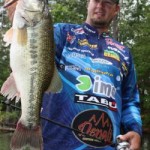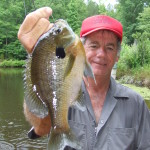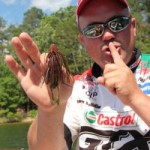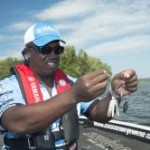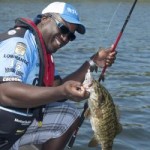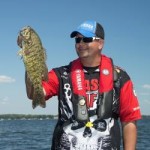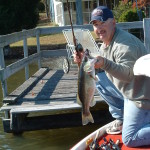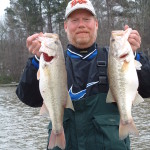
Roger caught these bass in Lake Oconee
Catching bass in the Altamaha River basin in Georgia offers a lot of different kinds of fishing.
Some waters just seem to produce better bass fishing. The Ocmulgee River, whose waters produced the world record bass, and the Oconee River join to form the Altamaha River. The lakes on the two rivers upstream are varied but excellent bass fishing waters, and the big river downstream of the junction is full of hungry bass.
On the upper end of the basin, Lake Jackson on the very upper end of the Ocmulgee and Lakes Sinclair and Oconee on the Oconee River are popular destinations for bass fishing. Although there are some similarities, all three lakes have their own types of cover and structure.
The Altamaha River itself can be intimidating if you don’t fish big rivers much but it can be excellent if you take the time to learn to fish it. It is very different from the lakes but all four places are definitely worth fishing right now.
Lake Jackson
Jackson, dammed in 1911, is one of our oldest lakes and it covers 4750 acres. The dam is on the Ocmulgee River downstream of where it forms at the junction of the South, Yellow and Alcovy Rivers. Its rocky shorelines are covered with docks and the lake has a reputation for big largemouth, but it is also full of spotted bass.
Kip Carter is a well known professional bass fisherman and Jackson is his home lake since grew up on it and lives nearby now. He knows it well and this time of year is one of his favorites to fish it.
Bass fishing on Jackson in the spring centers on both the bass and shad spawn. Bass will move into spawning areas in waves, starting in March and continuing through April. Since the bass don’t all spawn at one time you can catch pre spawn, post spawn and spawning bass right now. Kip says you can find bass on the bed almost any day in April.
The shad spawn in April provides some of the best fishing of the year. When the shad move to seawalls and riprap to spawn the bass concentrate on them, eating their fill every day. They are so voracious they will often eat until you can see the tails of the last shad they swallowed sticking out of their throat.
A wide variety of baits will catch bass now on Jackson. While the shad are spawning a white buzz bait or white spinnerbait with silver blades is definitely a go-to bait. Use a one quarter ounce bait for most fishing, but go to a half ounce spinnerbait if you want to concentrate on bigger bass.
Early in the morning you will see the shad schools running the seawalls and riprap. Points on the main lake are best, especially if the channel swings in by them, but secondary points back in the coves are also good. You should move fast until you find the shad spawning then slow down.
Throw your bait right on the bank and work it out at a 45 degree or less angle. The bass will be right on the bank early. After the sun gets on the water back off and slow roll your spinnerbait, covering deeper water where the bass are holding after the shad back off the bank.
Also try a jerk bait after the sun comes up. Cast near the bank and work it back in a jerk – jerk – pause action, making it look like an injured shad trying to get back to the school. Shad colors work best.
During the day Kip targets shallow cover lake brush piles, blowdowns and docks in the coves. A brown jig with a brown or pumpkinseed trailer is one of the best baits to fish around this cover and a three eights to one quarter ounce jig will fall slowly and not get hung as much. It will also draw strikes from any bass on the bed you spot.
A weightless worm will get bit better than just about any other bait, day to day, this time of year. Kip sticks with natural colors rather than the bright worms some favor and watches his line for the bites rather than just watching the bait. He says the natural colors will draw more strikes than the brighter colors.
If you like worm fishing both a Carolina or jig head worm will catch fish. And they are better for fishing a little deeper. Try a Baby Brush Hog on the Carolina rig and a straight worm like a Trick worm on the jig head. Stick with natural colors like green pumpkin and fish rocky points and creek channel drops with them.
Lake Oconee
Lake Oconee is on the upper Oconee River just south of I-20 and is one of our newest lakes. It has it everything bass like with defined channels, deep points, riprap, docks, roadbeds, grass beds and standing timber. With a slot limit protecting 11 to 14 inch long bass it produces a lot of them that size that are fun to catch. It also means there are a lot of bass longer than 14 inches in the lake.
Roger McKee guides on Oconee and does well in a lot of tournaments there. He says the bite centers around the bass spawning movement and the shad spawn on Oconee like it does on Jackson.
A spinnerbait and crankbait are good baits to locate the bass on Oconee and also catch the bigger bass needed in tournaments. Roger will fish both baits fast, looking for active fish. He says he would choose a crankbait if he could use only one bait on Oconee right now.
Use white spinnerbaits with a gold and silver blade in clear water but go to more chartreuse in the bait as it gets more stained. Shad colored crankbaits are better in clear water but also use more chartreuse baits in stained to muddy water.
Many big bass spawn on Oconee in March so they are on an active feeding spree now, and there will also be pre spawn bass moving in as well as bass on the beds. Secondary points in the coves and smaller creeks are the key to both pre and post spawn bass and Roger will hit as many as he can. By fishing his crankbait or spinnerbait fast he can cover a lot of water, and fast moving baits make it harder for a bass to see it is a fake and will draw reaction strikes.
The very back of the cuts and pockets behind these secondary points are where the bass spawn, so look to them for big females on the bed. Roger says some of the biggest bass of the year can be caught off the beds if you have the patients to soak a jig and pig or worm in them.
A weightless worm will also catch fish back in the pockets now. Fish it around any cover like stumps, brush, blowdowns and grass. Try working it fast just under the surface first but it you don’t get hit slow it down. Jerk it and make it dart, then let it sink. Watch your line and if you see any tick or movement set the hook.
Roger also fishes a jig and pig and Carolina rig on Oconee. The Carolina rig is good on the secondary points, especially if you get a couple of bites on fast moving spinnerbaits or crankbaits on one. Slow down and work it with a worm on a Carolina rig.
Fish the jig and pig on the same points, but also throw it around brush, blowdowns and stumps. Fish a brown jig and trailer in clear water but go to a black and blue jig and trailer in stained water. Work the bait slowly with hops on the points and jiggle it on wood cover.
During the shad spawn all the bass on the lake, unless they are locked in on the bed, will feed on them. Shad prefer hard cover like riprap and seawalls to lay their eggs seawalls with riprap are all over the lake. Fish your spinnerbait fast on them early in the morning close to the rocks then slow it down some as the sun comes up.
Lake Sinclair
Lake Sinclair backs up to the Oconee Dam but varies a good bit from it since it is an older lake. Many coves have grass like water willow in them and the docks tend to be older and have more brush piles around them. There is no slot limit on bass and Sinclair bass tend to run smaller, with lots of 11 to 13 inch bass being caught every day.
Both my bass clubs fish Sinclair this time of year since we catch so many bass there and there are so many different patterns you can fish. The bass spawn is in full swing and the shad spawn will take place during the month.
When the shad are not spawning, start early in the mornings with a white and chartreuse buzzbait or spinnerbait back in the coves around the grass. These grass beds are full of bluegill and bass love to eat them. If the grass is not too thick throw to the back side of it and work your bait out. If it is thick cast into it as far as you can without getting your bait clogged up.
Keep the buzzbait moving steadily but drop the spinnerbait at the edge of the grass in any holes or cuts. Let it flutter down a few inches then pull it forward. Bass will often eat it as it stops and flutters.
Floating worms are also good in the grass. Fish them in the grass, letting the bait fall into any holes and at the edge. A white Trick worm is good since you can see it and keep track of where it is and when it disappears, set the hook.
After the sun gets up back off to secondary points and fish a three sixteenths ounce jig head with a green pumpkin worm on it. Drag it along the bottom, with a hop a few inches high every foot or so. Some JJ’s Magic chartreuse dye on the tail mimics the fins of a bluegill and helps you get more hits.
During the shad spawn fish a three sixteenths ounce white spinnerbait with two silver willowleaf blades on riprap, seawalls and around the grass, too. Shad will spawn on the grass as well as the wood and rocks. Watch for flickers of shad as the school moves down the bank.
Cast as shallow as you can, even to the point of landing your bait on the bank and pulling it off. It often seems a bass will sit with his nose right on the rocks, waiting on a shad to come by. You don’t want to cast behind them.
After the sun gets on the water and the shad quit moving, back off the cover and reel the same spinnerbait slowly, keeping it right over the bottom. Fish it out to at least eight feet of water since bass will back off to that depth after feeding.
Docks are also hold a lot of bass this time of year and you can catch them by running a shad colored crankbait or your spinnerbait beside the posts and over brush piles around them. Also pitch a black and blue jig and pig to the docks, getting back under them as far as you can when the sun is bright.
Try to bring your jig and pig right beside every post. When you hit brush stop your bait and jiggle it in one place to get a reluctant bass to eat it. Make it look like an easy meal for a lazy bass.
Altamaha River
The Altamaha River starts south of Vidalia where the Omulgee and Oconee Rivers join. It is a big river with lots of current but also has many pockets and backwaters with overhanging trees and bushes. These pockets are where the bass move in the spring to spawn, so that is where you want to fish.
This is pretty simple fishing since you will be casting to visible cover in shallow water. One of the best tactics is to skip a weightless worm under overhanging limbs of willow trees. Let it sink to the bottom and settle for a few seconds. Watch for your line to start moving off when a bass picks it up. Use natural colored worms like green pumpkin or black.
Also study the backout. If it is a small creek entering the river it will often have a channel the bass will follow. Target stumps and other wood cover along the channel with a chartreuse and white spinnerbait with one gold and one silver willowleaf blade. Run the bait over the wood then let it fall as it passes.
If the backout is an old oxbow, usually one side will be deeper. Bass often hold on this deeper side on wood and grass. A spinnerbait fish beside the cover is good but also try a black and blue jig and pig flipped into the heaviest cover on this deeper bank.
The Altamaha River drainage offers lots of different fishing opportunities. Give them all a try.
